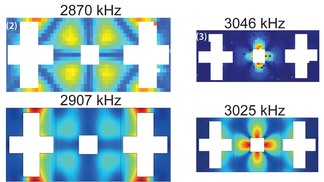May 19 2014
Prof. Villanueva and collaborators demonstrate the reduction of acoustic losses through the clamping substrate in nanomechanical resonators by using a phononic crystal structure. Paper published in Optics Express.
 © 2014 EPFL
© 2014 EPFL
Dielectric membranes with exceptional mechanical and optical properties present one of the most promising platforms in quantum opto-mechanics. The performance of stressed silicon nitride nanomembranes as mechanical resonators notoriously depends on how their frame is clamped to the sample mount, which in practice usually necessitates delicate, and difficult-to-reproduce mounting solutions. Here, we demonstrate that a phononic bandgap shield integrated in the membrane’s silicon frame eliminates this dependence, by suppressing dissipation through phonon tunneling. We dry-etch the membrane’s frame so that it assumes the form of a cm-sized bridge featuring a 1-dimensional periodic pattern, whose phononic density of states is tailored to exhibit one, or several, full band gaps around the membrane’s high-Q modes in the MHz-range. We quantify the effectiveness of this phononic bandgap shield by optical interferometry measuring both the suppressed transmission of vibrations, as well as the influence of frame clamping conditions on the membrane modes. We find suppressions up to 40 dB and, for three different realized phononic structures, consistently observe significant suppression of the dependence of the membrane’s modes on sample clamping—if the mode’s frequency lies in the bandgap. As a result, we achieve membrane mode quality factors of 5x106 with samples that are tightly bolted to the 8 K-cold finger of a cryostat. Q·f -products of 6·1012 Hz at 300 K and 14·1012 Hz at 8 K are observed, satisfying one of the main requirements for optical cooling of mechanical vibrations to their quantum ground-state.